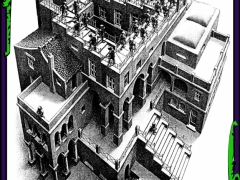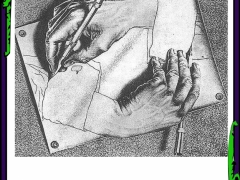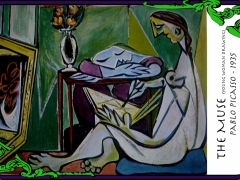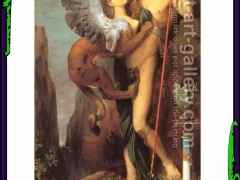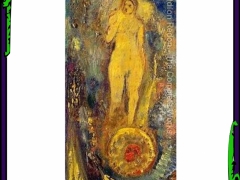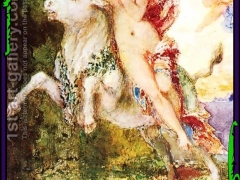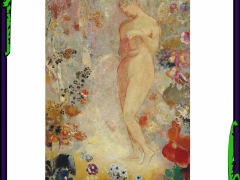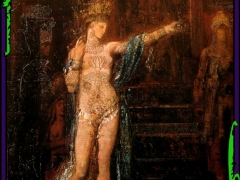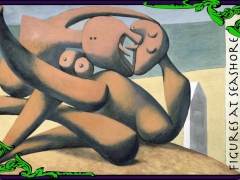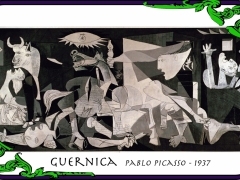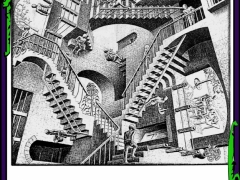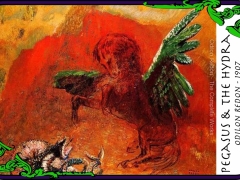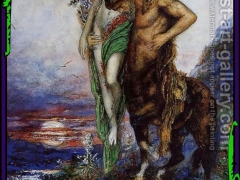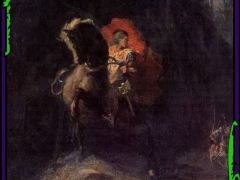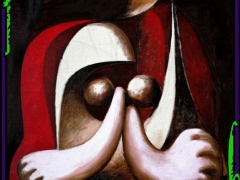When I took Art History in winter 2013 with teacher Johanne Yakula, our final project was this:
-Discuss four different artists from two different time periods, with four images from each artist. Be Creative.
I took this, ran with it and received a very gracious mark.. Here is my final project, a short story called the Fortune Teller about a Tarot Card reader. When the images come up, simply click next on the viewer to see the card.
The Fortune Teller
The Fortune Teller woke to the same beeping alarm in the same bed, in the same apartment she’d woken in for the last two years. She combed through the same closet of clothes she’d brought with her to the city, got dressed and set about making the same orange spice tea she drank every morning. Afterwards, she walked to her desk to retrieve her special deck of Tarot cards. It was a deck composed completely with pieces of art, a gift from her former lover. It was the last trace that they had ever shared an apartment together, the rest she’d thrown out or donated, but the deck of cards was an item she could not bare to part with. Her mother had had a natural intuition, her grandmother a psychic sense that made hairs stand on end, rumor had it her great grandmother had been burned at the stake, the Fortune Teller however, had no special abilities that she could tell. She was a reader of symbols and nothing more. Sure, you throw a few gothic statues in the window, light some incense and dim the lights in the shop and most customers leave with the sense of having seen an honest to goodness psychic. The Fortune Teller knew though, that the client did most of the work. They shuffled the deck, picked the cards and interpreted the symbolism she pointed out so that it applied to their own lives. Mind you, she was very good at reading symbols and even better at reading people. She picked up the deck of art cards and unwrapped the fabric she used to keep them together. The Fortune Teller closed her eyes and cut the deck, slipping the top card out and flipping it over.
She opened her eyes and looked at her card. Ascending and Descending by M.C. Escher. She studied the magical way Escher had constructed the piece of art to deceive the eyes. Around and around and around went the people, never stopping, never gaining, stuck in an endless cycle of stairs. “Well, that’s certainly appropriate,” the Fortune Teller said aloud as she tucked the deck away and left her apartment.
As she walked the street towards the little shop where she worked, the Fortune Teller couldn’t help but think about the Dutch artist Escher, who had always been one of her favorites. She felt a strange connection to him and his impossible drawings, woodcuts and mezzotints. Perhaps it was that like Maurits Cornelis Escher, nicknamed ‘Mauk’, she was a sickly child and often fell behind in school. Born in Leeuwarden in 1898, but raised in Arnhem, Escher was often sick and was placed in a special school at age seven where he failed the second grade. Though he excelled at arts, particularly drawing, his grades were generally poor. The Fortune Teller was the same way growing up except while Escher had been accepted to the Haarlem School of Architecture and Decorative Arts when he was 21, she only fell further away from any sort of formal education. She did, however spend time traveling as he did. Nothing as stunning as Italy and Spain, but she’d seen much of her own country. Escher had moved for several reasons, from Rome to Switzerland to escape the fanaticism of Benito Mussolini in 1935, from Switzerland to Brussels, Belgium because he missed the Italian landscapes, then back to the Netherlands, settling in a town called Baarn where his family escaped the second World War. The Fortune Teller had mostly moved out of boredom or, she sighed at the thought, love. She only hoped she could be as lucky as Escher who spent his final days in a retirement home in Laren specifically designed for artists.
It was interesting to her that the morning had started off with a surrealist piece, as the city itself had a surreal sensation to it. The clouds that hung ominously overtop threatening to downpour at any moment, the dim mist that billowed off the river, the sounds of the cars, the conversations in the street, everything felt dreamlike. A crowd had gathered on the bridge she crossed everyday on he way to work. The Fortune Teller politely excused her way through the greedy onlookers, each hoping to get a view of whatever it was that was happening. She passed by June, the lovely woman who owned a flower shop down the street from where she read cards.
“Morning June.”
“Good Morning.” June said back, only momentarily looking away from the river commotion.
“What’s all the fuss about?”
“Oh,” June said as though she hadn’t noticed. “Looks like another one.”
“Really?” The Fortune Teller sighed sadly. The bridge she crossed every day had a real name and at one point she actually knew that name, however she had grown to know it by its morbid pseudonym.
“Yep, looks like Death Bridge took another one. You know, no ones ever gonna call it anything else if people don’t stop jumping off it.” June said plainly. The Fortune Teller nodded goodbye as hurried out to avoid the growing crowd. She had once been told by a fellow psychic that there was a convergence of planetary energy lines right where the bridge was and that was why people threw themselves off it so often. It also happened to be the same cross section of energy where the shop she read cards out of was, right at the base of the Spiro building. She had on several occasions walked around the building in between clients. Built during yet another Gothic revival, it had many nonsensical halls that led to nowhere, 13 lights in every hall, 13 stairs in each well, Greek and Egyptian symbols any and everywhere, it was a veritable mish-mash of cultures and periods. One of those buildings that was never made like that and never would be again, like the building from Ghostbusters or the Winnipeg Legislature. Though the building gave her a distinct uneasy feeling, the energy in her workspace was good. The Fortune Teller opened up the shop, lit some incense, dimmed the lights and began setting up for the day’s first client.
The Fortune Teller’s first client that day was a woman in her late 20’s named Maria. Maria was a steady client, visiting a few times a year, or when something drastic changed in her life. She was a timid girl, often kept to herself and had dreams of composing a series of children’s books. Maria and the Fortune Teller exchanged pleasantries briefly and Maria sat down, instinctively shuffling the deck of Tarot cards. The Fortune Teller found her spot at the other end of the table in her red chair. She had gone out of her way to find that chair. It fit her body perfectly and when your job consists of you sitting for most of the day, a solid chair is important, the fact that it was red, her favorite color, was purely a bonus. Maria cut the deck and passed the cards across the table to the Fortune Teller who flipped the first card over.
It was another Escher and perhaps his most commonly known work at that. Drawing Hands. The work put into this masterpiece had always astonished the Fortune Teller. One hand sprouting from the paper its being drawn on, only to draw another hand that sprouts from the paper to draw it. M.C. Escher certainly did enjoy exploring concepts like infinity and illusionary drawing. It was interesting that another Surrealist card had been drawn, not surprising, as many days would often have themes to them. The Surrealist movement began as a literary movement in the late 1910’s and early 1920’s and experimented with new modes of expression like automatic writing, which aimed to release subconscious thoughts onto the page, quite like Tarot cards were chosen by one’s subconscious. Using Freudian methods of free association, their art began to pull on the hidden parts of the mind, normally obscured by logic, social limitation and reason. The movement gained most of its momentum between the two world wars and began to include not only automatism (automatic writing/drawing), but forms of illusionistic surrealism which distorted space, shadows and objects with incredible precision. Famous Surrealists include Salvidor Dali, Paul Delvaux and Yves Tanguy. Though neither considered themselves to be any sort of ‘-ist’, both M.C. Escher and Pablo Picasso have many works of art that are considered Surrealist. Picasso even began using the very popular minotaur in his works, a symbol of the movement and participated in many of their exhibitions and activities in Paris. There is a very clear distortion of reality in Surrealism and they most definitely find ancestry in the clever and whimsical Dadaism that preceded it and descendants in Abstract Expressionism.
“So?” Maria rubbed her hands together nervously.
“Balance.” Said the Fortune Teller. “One hand draws the other in an eternal loop, neither able to exist without the other. This card shows that you’ve recently struck a balance within yourself, perhaps even, with another.” Maria nodded approvingly, as though it were information she already knew. The Fortune Teller flipped another card.
She turned the card landscape so it crossed the last and showed the image properly. The Muse (Young Woman Drawing) by Pablo Picasso. She smiled.
“Interesting,” she said.
“What? Why?” Inquired Maria.
“Pulling a Picasso is always a good thing for an artist such as yourself Maria. Picasso was arguably the most prolific artist in our history. Born in 1881, he was a Spanish painter, sculptor, printmaker, ceramicist, stage designer, he helped revolutionize the plastic arts… many, many things. He was a prodigy, demonstrating incredible artistic talent at a young age, painting such realistic works, but he was never satisfied. He had such a need to explore and experiment. Picasso spent many years just studying lines. It’s what helped him develop Cubism. After World War 1 he and many other artists went back to a brief neoclassical style, a sort of attempt to put the world back in order. It wasn’t long however, before he found himself inspired by Surrealist painters and his work became more distorted.”
“So, is this a bad card?”
“No. This card tells me two things. One, you’re writing again and its flowing freely.”
“I am.”
“And two, its due in part to whomever it is you’ve met. A new lover perhaps?”
Maria blushed and smiled. “How did you know?”
“Marie-Thérèse Walter. Though Picasso was married he saw her shopping in Paris one day and as the story goes walked up to her and said ‘Miss, you have an interesting face. I would like to do your portrait. I have a feeling we will do great things together. I am Picasso.’ Nice pick up line, right?”
“Would’ve worked on me,” she replied.
“Anyway, he painted her a lot. Time and time again in many different styles. Ultimately, as their relationship deteriorated, along with problems with his wife Olga, the women in his art became more and more broken and distorted looking. This work, however, is from early in the relationship and has a very positive vibe to it.”
“Oh, good,” she sighed.
“Let’s see what else is going on here.” The Fortune Teller flipped the next card.
Oedipus and the Sphinx by Gustave Moreau. A symbolist painting. One of Moreau’s most important too. Still virtually unheard of at 38 years old, he triumphed at the Salon of 1864 with this work, a piece that reflected both is knowledge of Ingre’s version of the same subject and his time studying painter Andrea Mantegna at the Louvre. The Fortune Teller smiled politely. “I can’t tell you that.”
“I’m sorry?”
“This card, Oedipus and the Sphinx. This is the moment when Oedipus confronts the winged monster outside of Thebes and has to solve her riddle. Its the posing of a question, an important question. You want me to tell you whether or not you should continue to see this man you’ve met.”
“Well, yes, it is kind of why I’m here.”
“Why do you hesitate?”
“He’s been married before. Actually, he has two kids, a boy and a girl, and even though he makes me feel so… swirly and I’m writing again, I just-” Maria paused, ashamed of what she was saying. “-I just don’t know if I’m ready to be in a family. I’m so used to my life as it is.”
“I see. Let’s look at what your last card is, maybe there will be some insight.”
The Fortune Teller mused. She could’ve told Maria exactly what card was going to follow, but revealing it was more fun. The Wheel of Fortune by Odilon Redon.
“Ah, Rota Fortunae.”
“Is that bad?”
“Yes and no. Its bad, good, alright, fair, terrible, awesome and more. You see the figure standing here is the Greek Goddess Fortuna, Goddess of Fortune, Luck and Fate. She’s almost always depicted in front of her wheel of Fortune, a wheel that dictates the many fates a future may hold, often she’s even shown wearing a blindfold. Its about the capricious nature of Fate.”
“I don’t understand.”
“Well, you see here, Fortuna stands in contemplation over the wheel. There are many different possibly outcomes on the wheel and I would say right now, that is you. Things could turn out bad, sure. Things could also turn out very good. But in order to find out, you’ll have to spin the wheel.”
Maria nodded and sighed. “I’ll never know unless I give it a chance.”
“That’s what the cards say.”
Maria thanked the Fortune Teller and paid her for her reading. The Fortune Teller briefly turned on the television while waiting for her next client. There was no update on the most recent jumper, only that there had been one and the identity had not yet been released. She glumly turned the television off and cut the cards. She flipped over a card for herself.
It was another work of Symbolism. Europa and the Bull by Gustave Moreau. It made sense. A movement that began in the 1880’s as a French literary movement, Symbolist painters believed that art should reflect an emotion or idea rather than represent the natural world. It was a reaction to Realism and Impressionism, the two ruling art forms of the time. Returning to more of a personal expression advocated by the Romantics earlier in the century, they felt that the symbolic value or meaning of the work stemmed from the recreation of emotional experiences. Symbolism expressed this through their use of color, line and composition. Wanting to imbue their works with spiritual value, they produced imaginary dream worlds populated with figures from the bible, greek mythology and often fantastic, monstrous creatures. Unlike other movements they did not share a specific artistic style, rather a pessimism and weariness of decadence they perceived in modern society.
Gustave Moreau was born in Paris. He studied under the guidance of Francois-Edouard Picot and befriended Theodore Chasseriau, whose work influenced his own. During his lifetime he composed over 8,000 paintings, watercolors and drawings. His preference was for mystic and intense images, containing long-dead civilizations and mythologies. He was once quoted as saying, “No one could have less faith in the absolute and definitive importance of the work created by man, because I believe that this world is nothing but a dream…”
It was the same way the Fortune Teller felt most days, that the world was nothing but a dream. Her own version of Europa and the Bull, being the nightmare that started it all. In the tale, Europa is a fair Phonecian woman of high lineage adored by Zeus. One day he took the form of a bull and hid amongst her father’s bulls. Europa came along and feed the beasts as she often did and after noticing the Zeus bull, she climbed onto its back. Zeus ran off instantly into the sea and swam to Crete. He had his way with her and then left her there, where she became the first Cretean queen, a consolation prize for having been abandoned so far from home. Modern day scholars say that the story is a retelling of how Europa was kidnapped by a rival country, but for the Fortune Teller, it was the original story that rang true. She had, once upon a time, fallen in love with a man who had two faces. She moved to her current city with him, only to discover that he was not the prize bull she had mistaken him for. Shortly after, he left as Zeus did. She, however did not become a queen, rather just another face in a sea of people.
“Excuse me?” The woman’s voice shocked the Fortune Teller back to reality. “Sorry, I didn’t mean to startle you. I’m Patricia.”
“Yes, of course. I was expecting you. Please come sit.” The Fortune Teller invited the woman to the table and then sat herself in her comfy red chair.
She read the cards of Patricia, a lonely woman who turned up several Romanticism cards as she was searching for an ideal, not an actual partner. Afterwards, she had a walk-in. He was a businessman who sometimes consulted Astrology or Tarot to help him with financial decisions. He flipped up several portraitures and some Rococo pieces, indicating both his self absorption and frivolity. When he had gone, the Fortune Teller had lunch and watched the television. She skipped back and forth between a show on ancient architecture and the news. She was waiting for the announcement of the identity of the jumper. She was always morbidly concerned she would know the person. Seeing the time, she turned off the tv, lit some more incense and turned on some ambient music, dark chords with a middle eastern feel. She sat in her chair waiting for her final client of the day to arrive and momentarily saw her reflection in the window. There she was sitting in her chair, the spot across from her empty, it was a fitting representation of how she felt about her life. She was alone at a table for two. And it ate her up inside.
The bell on the front door rang as the final client came in. Her name was Wanda. She had been to see the Fortune Teller a few times before and the last time she’d pulled some cards that indicated significant events about to unfold, so she was looking forward to finding out how she had been. Wanda sat at the table with the Fortune Teller and while she shuffled the cards talked about her job promotion and recent engagement.
“That’s very exciting,” said the Fortune Teller. Wanda had been dating the same man for several years and she knew how important the engagement was to her.
“Yes it is. Though, with the promotion we haven’t been able to spend nearly as much time together.”
“That’s unfortunate.”
“It is.” Wanda said with a strange unease. She cut the deck and handed the cards across the table. The Fortune Teller took the silence as her cue to begin. She flipped the first card.
The Fortune Teller immediately raised an eyebrow. The card was Pandora by Odilon Redon. She was instantly overwhelmed with the feeling that Wanda’s current Fortune was not all it seemed to be. Bertrand-Jean Redon, better known as Odilon Redon was a French symbolist painter, printmaker, draughtsman and pastellist. His work represented an exploration of his internal feelings and psyche often filled with strange beings and grotesque dichotomies. He started drawing as a young child and at the age of 10 he was awarded a drawing prize at school. His father insisted on him becoming an architect, but upon failing the entrance exams to Paris‘ Ecole des Beaux-Arts his path became clearer. Redon remained relatively unknown until his appearance in an 1884 cult novel by Joris-Karl Huysman titled, Rebours (Against Nature). The story featured a decadent aristocrat who collected Redon’s drawings. In the last ten years of the century he began using pastel and oils, which would dominate his works for the rest of his life. Redon always wanted to “place the visible at the service of the invisible” and represent in picture, the ghosts of his own mind. Redon cards often represented just that, the leaking of subconscious thought into reality. Not just any thoughts though, the ‘ghosts’ in particular. Thoughts that haunt. Redon was never satisfied with reality. He would often paint a whole day replicating an object to the tiniest insignificant flaws, only to be left unhappy. It wasn’t until he allowed his imagination, his subconscious ‘ghosts’ to recollect the forms that he was reassured and appeased. Between 1908 and 1914, he turned to painting mythic beauties like Venus, Andromeda and Pandora.
“Pandora. She was fashioned from clay by Vulcan and sent to Earth by Jupiter. In this painting you see she is still innocent as she stands gracefully in the flowers.”
“What’s she cradling?” Wanda was very attentive.
“A box. Pandora’s Box. She holds in her hands the box that, when opened, will unleash all the evils destined to plague mankind, bringing about the end of the legendary Golden Age.”
“She looks like she’s unsure if she should open it.”
“Wouldn’t you be?”
“Yes.” Wanda swallowed. “But she has to, doesn’t she.” Wanda’s tone implied a double meaning.
“Yes, she does.” The Fortune Teller said supportively, understanding that her client had made a deep connection to the card.
“Please flip the next card.”
Tattooed Salome by Gustave Moreau. Sometimes called Salome Dances for Herodias or just plain Salome. She was not only a figure Moreau painted many times, but classically as well.
“Well?” Wanda asked.
“In Christian traditions, Salome is the icon of dangerous female seductiveness.” Wanda sighed and the Fortune Teller continued. “She dances for her father and he is so pleased he offers her anything she wants. Her mother convinces her to ask for the head of John the Baptist. Stories differ, but generally she is not pleased with actually receiving the head.”
“Careful what you wish for.”
“Maybe a warning, yes.” The Fortune Teller’s head flooded with a quote she’d once heard, Gustave Moreau commenting on his portrayal of Salome. He was looking to capture, ‘Women seeking unhealthy emotions and are too stupid to understand horror in the most appalling situations’. “It could also represent being blinded to cold reality by emotions.”
Wanda was silent. Emotion obviously boiled inside of her.
“Do you want me to continue?” The Fortune Teller asked. Wanda seemed shocked back into reality.
“Um, yes. Yes, please continue.”
Wanda shrieked as the Fortune Teller turned the card and laid it landscape style over the others. As the Fortune Teller looked at the distorted couple embracing on the beach in Picasso’s Figures at Seashore, she understood that what she had been sensing was obviously true. She handed Wanda a tissue and the woman wiped her tear filled eyes.
“How long have you suspected?” The Fortune Teller asked.
“Only a few months.” Wanda dabbed her eyes. “But I think I’ve known on some level much longer than that.” The Fortune Teller took her hand.
“I can’t say its okay, or that everything will be better, but I can say that its something I’ve experienced myself and you’ll survive.”
“Thank you. I just feel so stupid.
“Don’t, you weren’t the deceptive one.”
“I should’ve known though. I think I did. It just wasn’t until a few months ago, I’d forgotten my phone somewhere in the house and when I went to use his to call mine… well… Let’s just say there were some new multimedia messages that revealed a little to much of his co-worker. I knew then, but I still couldn’t admit it to myself until someone else said it.”
“I’m both sorry and happy to be the one who helped you.”
“I appreciate that.” Wanda blew her nose and waved her hands in her face, an attempt to speed the drying of the tear streams. “So? Last card?”
“Last card.” The Fortune Teller turned the final card over.
She placed the card directly overtop of Figures at Seashore, completely obscuring the twisted naked bodies. Wanda’s final card was Guernica by Pablo Picasso. Arguably Picasso’s most famous work, Guernica is a depiction of the German bombing of Guernica during the Spanish Civil War. The very large canvas (25.5’ X11.5’) embodies the inhumanity, brutality and hopelessness of war with it writhing bodies and symbolism. The lack of color in itself speaks volumes. The painting features the minotaur, symbol of Surrealism and Picasso’s statement of the beastliness of war, particularly its effect on innocent civilians. When asked to explain the symbolism, Picasso said, “It isn’t up to the painter to define the symbols. Otherwise it would be better if he wrote them out in so many words! The public who look at the picture must interpret the symbols as they understand them.” Which is exactly what Wanda did. She quietly studied the contours and imagery of Guernica for a few minutes before simply saying, “I understand.” She insisted on paying, though the Fortune Teller attempted to refuse and left to go begin the sad war waiting for her at home.
The Fortune Teller waved goodbye and then ran to the back room to cry for a moment. The situation had brought up many of her own ghosts and while she stayed composed for the client, she was human and needed to release. Upon returning to the main room, she cut the deck and drew herself a card.
Relativity by M.C. Escher. Back to Escher. Somehow the day had gone full circle. Relativity was such an unusual card and to her implicated the essence of what she did. She thought back to Escher’s writing about the piece.
‘Here we have three forces of gravity working perpendicularly to one another. Three earth-planes cut across each other at right-angles, and human beings are living on each of them. It is impossible for the inhabitants of different worlds to walk or sit or stand on the same floor, because they have differing conceptions of what is horizontal and what is vertical. Yet they may well share the use of the same staircase. On the top staircase illustrated here, two people are moving side by side and in the same direction, and yet one of them is going downstairs and the other upstairs. Contact between them is out of the question, because they live in different worlds and therefore can have no knowledge of each other’s existence.’
Though she felt for her clients, they lived in different worlds. She turned to go lock the front door while she closed out and jumped. A man stood in the entrance, silent and dripping wet. He must have come in while she was in the back.
“Sorry, I didn’t hear the bell. Please come sit down.” The man slowly came to the table, he didn’t make eye contact with her. “I didn’t realize it had started raining. It’s been threatening to all day though. Here-” She handed him a piece of cloth. He nodded and dabbed his face and hands dry. He returned the cloth and continued to stand silently. “Come for a reading then? I was just about to close, but I got nowhere to be. Have a seat.”
The television suddenly turned on. It blared loudly. The Fortune Teller grabbed the remote and muted the tv. “These old buildings and their power surges. So, what’s your name?”
The man looked at her as though she had asked him what was the 17th digit of Pi. He looked down at his fingers, then back up at her. “Tom. Thomas Mason.”
She smiled politely. He was weird, but admittedly, she’d had weirder. “Well Tom Mason, all you have to do is shuffle and cut.” She handed him the deck. His fingers touched hers as the passed the cards and they were freezing. “My goodness,” she rubbed her fingers. “How long were you out there?”
Tom did not respond. Instead he slowly shuffled the cards, cut them in half and passed them back to the Fortune Teller. When she touched the deck, she felt the strangest tingle down her spine and she momentarily squirmed in her red armchair. A cold uneasiness began to build in her stomach. She fought it off and flipped the first card.
She laid the card landscape style in front of her. Pegasus and the Hydra by Odilon Redon. It was not a great card.
“You’ve never felt like you belonged. Pegasus was the son of Poseidon and Medusa. An outcast from birth, Athena captured him and gave him to the muses to be used as a tool. Its said that under his hooves, inspiration flows. Yet, in the painting, the Pegasus rears back and his hooves do not touch anything, which could symbolize a loss of inspiration, or feeling cut off from the natural flow of things.” She looked up at the man, still wet. He expressed no emotion. His face seemed a permanent state of confusion. Like he was working out a great mystery. So she continued.
“The hydra is hopelessness. For every head cut off, two more grow back. Even after Hercules defeated the monster, the Gods would not acknowledge his triumph because he had the help of his cousin. The colors Odilon Redon used in this piece show great emotions. Intense anger, or fear… perhaps frustration…” Normally the client helped more, playing off her interpretations so that she could give a better reading. Tom Mason just sat and stared at the cards. So she pulled the next one.
Gravitation by M.C. Escher. Again, she thought back to Escher’s comments on the work.
‘A stellar dodecahedron, encased in twelve flat, five-pointed stars. On each of these platforms lives a tail- less monster with a long neck and four legs. He sits there with his rump caught beneath a flat-side pyramid each wall of which has an opening, and through this opening the creature sticks his head and legs. But the pointed extremity of one animal’s dwelling-platform is at the same time the wall of one of his fellow-sufferer’s prisons.’
“Monsters burst from your own stellar nature,” she said without thinking. “So many of them bubbling to the surface that you’re overwhelmed. Stuck in a sort of prison of your own creation.” She was never this bold with clients, but the words came as though channeled through her.
“Yes.” He said. “I… felt that way.” She took a deep breath and continued the reading.
Dead Poet Bourne by a Centaur by Gustave Moreau. The card was a death card. Though death could mean many things, change, growth, death of an aspect or personality trait, in Tom Mason’s case the Fortune Teller had the distinct impression that it represented actual physical death.
“Someone has died recently.” She said.
“Someone has died.” He parroted.
“The centaur represents a balanced individual. Someone of a dual nature who is perhaps mourning. Maybe they’re caring for the remains or… helping the dead move from one place to another.” Again, she said something strange without thinking. The reading was making the Fortune Teller incredibly uncomfortable. She glanced over his shoulder and saw that not only was it not raining outside, it was bone dry. It was then she decided to rush through the rest of the reading so she could get him out of her shop.
Roland at Roncevaux by Odilon Redon. It was his first known painting. Based on the song of Roland, a legend with many variations. It was accepted by the Salon right away, but he did not exhibit it until much later. The darkness of the piece and facelessness of Roland had always made her uncomfortable.
“The Battle of Roncevaux pass in 824 claimed many lives, including Roland, prefect to the march of Brittany. His tombstone lays on this pass still, more likely commemorating the romanticized legend of the great battle between Christian and Muslims there than the death of an actual man.”
“Death of a man.” He repeated.
“Tales differ. Some say he was slain by a child. Other say the Leonese hero Bernardo del Carpio. Either way, this painting is of Roland after the retreat from battle. Perhaps before they are ambushed by the Muslims and slain. Every time I’ve seen this piece though I get the impression its after that.
“After? What happens after?” Tom said in a monotone.
“He’s alone here, you see. Traveling through the pass, maybe out of it. But the way he’s looking around… he knows.”
“Knows what?”
“Roland knows he’s at the end of his life. He knows its about to find him.”
“What is?”
“Death.”
“Death.” Tom said.
“In a way, this painting has always made me sad because, he’s already dead and he knows it.
“Already dead.”
“Yes. This is the moment where he comes to terms with the fact he’s dead.” She said, staring at the card.
“Yes.” Tom’s voice raised partially. “Already. Already dead.”
The Fortune Teller looked up to make another comment, but the man was gone. She looked around the room, but a part of her knew that all he left behind was a wet mark on the chair. She sat back in her chair and let out a long breath. She shook the uncomfortable feeling off her shoulders and arms, only to have it return instantly as she looked up at the television. The police had finally released the identity of the body they pulled from the river that morning. They flashed his face on the screen followed by his name underneath. Tom Mason found dead this morning. She turned off the television and sat in silence for a moment. After another deep breath she flipped the top card of the deck over.
In the reflection of the window, she saw herself sitting in her red chair. She was alone at a table for two. For once, she was okay with that.


